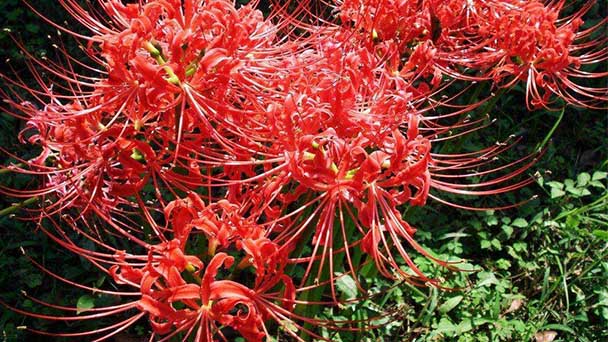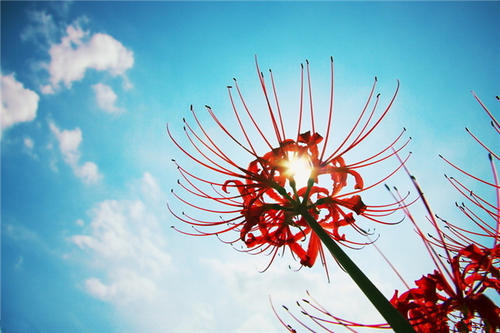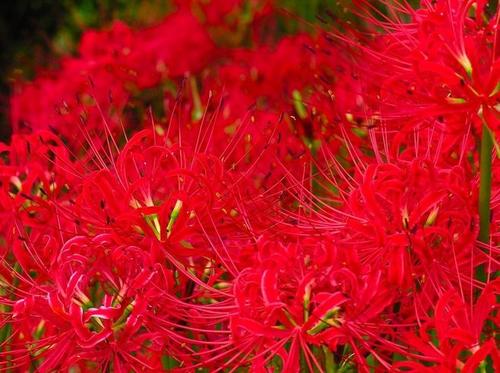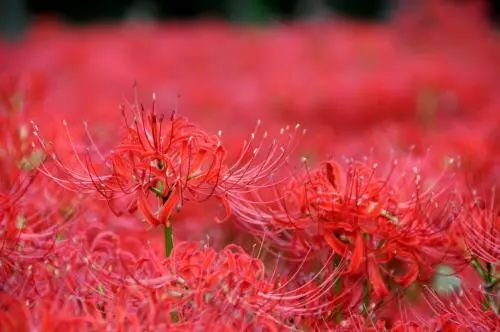Lycoris radiata profile
Written by Maggie
Mar 09 2021

The bulbs of Lycoris radiata are nearly spherical, 1-3 cm in diameter. The leaves emerge in autumn. The leaves are narrow and band-shaped, about 15 cm long and 0.5 cm wide, with a blunt tip, dark green, and a pink-green band in the middle. Flower stem is about 30 cm high; 2 involucral bracts, lanceolate, about 35 cm long and about 05 cm wide; umbels have 4-7 flowers, bright red flowers; perianth lobes narrow oblanceolate, long Approximately 3 cm, width of about 05 cm, strength shrinkage and reverse curl, perianth is simple green, about 05 cm in length; stamens prominently protrude from the perianth, about twice as long as the perianth. Flowering period is from August to September, fruiting period in October.
Lycoris radiata is wild in the damp hillsides and streams. Lycoris radiata is distributed in many places in China, and also in Japan. Lycoris radiata is cultivated and has high horticultural value.
Lycoris radiata info
| Botanical Name | Lycoris radiata |
| Common Names | spider lily |
| Plant Type | Amaryllidaceae |
| BLOOM COLOR | Red |
| Light | Full sun to part shade |
| Cold hardiness | 6 to 10 |
| Native Range | Japan |
| Mature size | 1.00 to 2.00 feet high, 1.00 to 1.50 feet wide |
Lycoris radiata picture

Morphological characteristics of Lycoris radiata
Lycoris radiata is a perennial herb with a nearly spherical bulb with a diameter of 1-3 cm. The leaves emerge in autumn. The leaves are narrow and band-shaped, about 15 cm long and 0.5 cm wide, with a blunt tip, dark green, and a pink-green band in the middle. Flower stem is about 30 cm high; 2 involucral bracts, lanceolate, about 35 cm long and about 05 cm wide; umbels have 4-7 flowers, bright red flowers; perianth lobes narrow oblanceolate, long Approximately 3 cm, width of about 05 cm, strength shrinkage and reverse curl, perianth is simple green, about 05 cm in length; stamens prominently protrude from the perianth, about twice as long as the perianth. Flowering period is from August to September, fruiting period in October.
Lycoris radiata habitat
Lycoris radiata is wild on wet hillsides and streams; it is also cultivated in gardens. Distributed in China's Shandong, Henan, Anhui, Jiangsu, Zhejiang, Jiangxi, Fujian, Hubei, Hunan, Guangdong, Guangxi, Shaanxi, Sichuan, Guizhou, Yunnan. Japan also has it. The type specimens were collected from my country, but the place of origin is unknown.
Lycoris radiata growth habit
Lycoris radiata wild species grows in gloomy and humid land, where it is born in red soil, so it has strong cold tolerance and is shade-loving. The tolerable high temperature limit is 24℃; it likes humidity and is also resistant to drought. It is accustomed to acidic soil. Loose, fertile humus soil is best. Have summer dormancy habits. Lycoris radiata is adaptable and hardy. The soil requirements are not strict. It is better to use humus-rich soil and a damp and well-drained environment with a pH value of 6-7. In nature, it is often found in relatively humid and well-drained places such as gentle slope forest edges and streams. It can also grow in places where the rocky soil layer is slightly deeper on the top of the hilly mountainous area.
Lycoris radiata reproduction method
Root seed splitting
The method of dividing the ball, sowing, cutting the scale base and tissue culture, etc. is the main method of reproduction. The easiest way is to divide the ball, dig up the plant during the dormant period or after flowering, remove the epiphyte near the cue ball and plant it, and it will bloom in about one or two years. Seed-prone species can also be propagated by sowing, but it usually takes two to five years to bloom. For large bulbs, the large bulbs can be cut into eight to sixteen pieces radially and inserted into a clean sand bed, and they can grow into new plants in about three to four months.
Scale cutting
Cut the base of the cleaned Lycoris radiata bulb in eighth with a m-shape, the cutting depth is about 1/2-2/3 of the bulb length. After disinfection and drying in the shade, it is inserted into a substrate such as moist sand or perlite. After 3 months, adventitious buds can be seen at the junction of the scales and the base plate, and small bulb bulbs gradually emerge, which can become seedlings after separation and cultivation.

Tissue culture
Lycoris radiata uses MS medium to collect pedicels and ovaries as explant materials. After culture, callus can be produced at the incision. Adventitious roots can form after 1 month, and adventitious buds can form after 3-4 months. Using pedicels and stem-bearing scales as explant materials can also produce adventitious buds and subcorms.
Breeding seeding method
Lycoris radiata is generally only used for cross breeding. Since the seeds are not dormant, they should be sown immediately after harvesting, and the radicals can be seen after 15 days at 20℃. When sowing in a natural environment, only a few seedlings can pull out a leaf in the first growth cycle. The seedling stage can be transplanted once. It takes about 4-5 years for seedlings from sowing to flowering.
Lycoris radiata main value
gardening
Lycoris radiata is a common garden ornamental plant in East Asia. You can admire its leaves in winter and its flowers in autumn. It is an excellent perennial herbaceous flower. It is often used in gardens for shade greening or understory ground cover flowers, flower borders or natural planting between mountains and rocks. Because of its flowering time, it should be matched with other more resistant herbs. It can be used as a flower bed or flower path material, and it is also a beautiful cut flower.
medicine
The bulb of Lycoris radiata contains more than ten kinds of alkaloids such as lycoline, pseudolycorine, narcissus, ricoramine, galantamine, etc.; it has detoxification, expectorant, diuretic, emetic, and insecticidal effects. But it has a small poison; mainly treats sore throat, carbuncle and sore toxin, scrofula, nephritis and edema, snake bites, etc.; Lycorisin has certain anti-cancer activity, and can resist inflammation, antipyretic, sedative and emetic; Min and licoramine are essential medicines for the treatment of polio.
Bulb (lycoris radiata): pungent, warm. There is little poison, detoxification, expectorant, diuretic, vomiting. Lycoris radiata is used for sore throat, edema; unfavorable urination, carbuncle swelling and sore poison, scrofula, cough, phlegm, food poisoning.

Latest Updated
- Benefits of Bugleweed - 7 Science-backed Health Benefits
- Bugleweed Dangers & Side Effects - Is It Poisonous?
- How to Plant Evergreen Trees - What You Should Know
- When to Plant Evergreens - Grow Guide for Evergreen Trees
- 12 Wonderful Evergreen Shrubs for Your Garden
- 12 Popular Evergreen Plants with Pictures for Beginners
- When And How To Prune A Lilac Bush Like a Pro
- How to Grow & Care for Lilac Vine (Hardenbergia Violacea)
- Japanese Lilac Tree (Syringa Reticulata) Care & Propagation Guide
- Shumard Oak Pros and Cons - What to Know
Popular Articles
- Winter maintenance of Antirrhinum Majus
- How to Grow Terminalia Mantaly Tree
- How to Grow and Care for Crossostephium Chinense
- How to grow Antirrhinum Majus in spring
- Peristeria Elata (Dove Orchid) Profile: Info & Care Guide
- Underwatered Snake Plant (Sansevieria Trifasciata) - Signs And How To Fix
- How to Care for Brazilian Jasmine Plant (Mandevilla Sanderi)
- How to Grow & Care for Graptopetalum Purple Delight in Summer
- Rosa Chinensis (China Rose): Plant Growing & Care Tips
- How to Care for Baby Sun Rose (Aptenia Cordifolia)